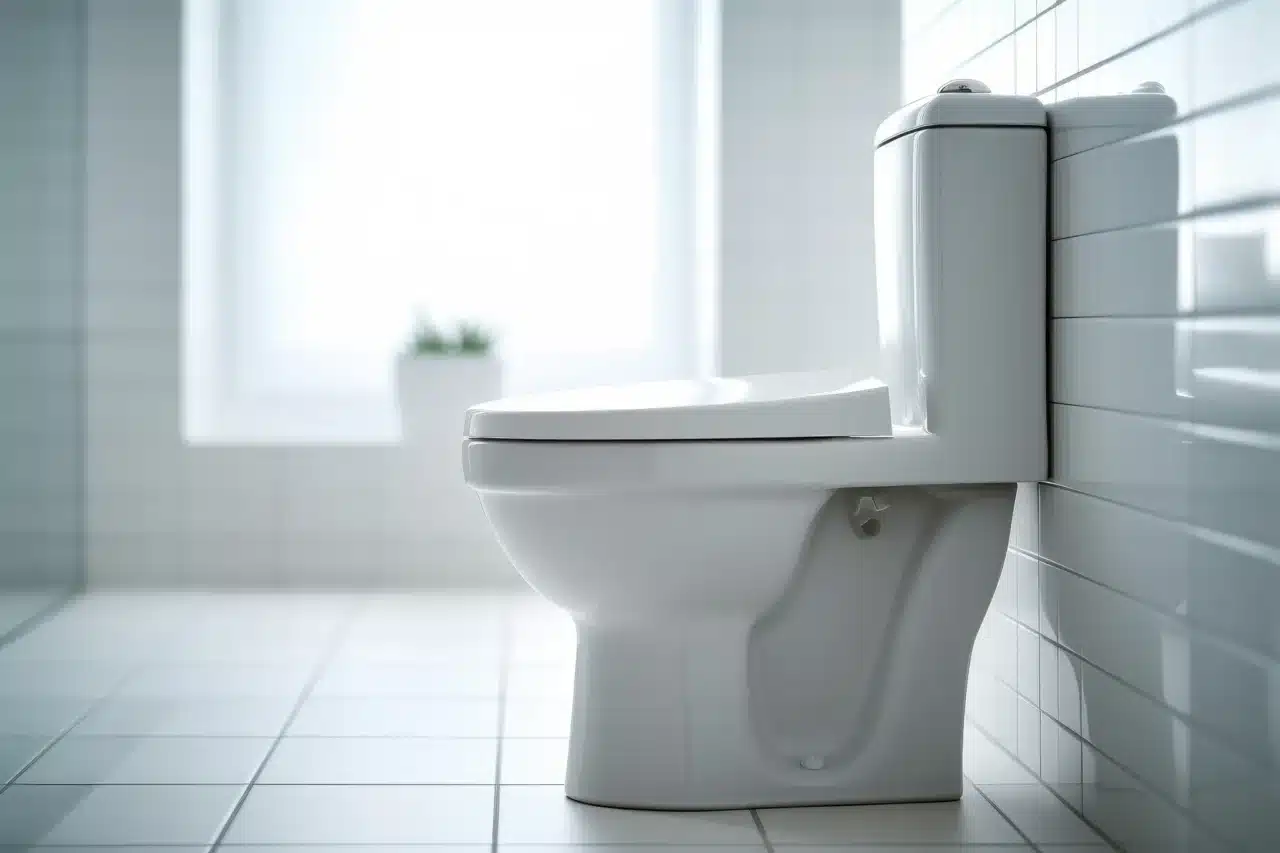You flush the toilet and BAM. A sharp bang echoes through the pipes. Then comes a high-pitched squeal that could wake the dog. Or the relentless hissing that never seems to quit. Whatever the sound, your toilet’s trying to tell you something. And you can probably guess, it’s not good.
Worried something’s about to break? Embarrassed when guests hear it? This guide breaks down the possible causes and explains how to fix them without calling in backup.
Of course, if you do need backup, we’ve been handling plumbing problems in the Southeast since 1944. Let’s dive in.
Why Does Your Toilet Make Loud Noises?
A toilet should flush and refill with quiet confidence. Not theatrics. If your toilet’s making noise long after the job’s done, it’s not just age or bad luck. Here’s how to figure out what you’re dealing with and what it means.
Water Hammer (Banging Pipes)
If your toilet makes a loud banging noise after flushing, you’re likely dealing with the appropriately named “water hammer.” It happens when a fast-closing fill valve suddenly stops the water flow, sending a shockwave through the pipes.
This pressure spike can loosen joints, stress your plumbing, and eventually lead to pipe damage.
Older homes without built-in arrestors are especially prone to this kind of plumbing trauma.
Whistling or Screeching Fill Valve
Hearing a piercing whistle or screech when the tank refills? That’s your fill valve. Over time, the rubber diaphragm inside breaks down or traps debris, making the refill process sound like a boiling kettle.
This is one of the most common causes behind a toilet whistling sound, especially in humid Southeastern climates where minerals and sediment build up faster than most homeowners expect.
Vibrating or “Fog-Horn” Sound
This one’s unmistakable. If your toilet roars like a cruise ship horn every time you flush, blame a loose or aging washer inside the shut-off valve or ballcock assembly.
As water flows through, the washer vibrates violently, creating that deep rumble you can feel in your chest. It’s loud, it’s dramatic, and it’ll only get worse until you replace the faulty part.
Bathrooms near the water heater or on upper floors tend to amplify this even more.
Bubbling or Gurgling
If you flush and hear bubbling or gurgling in the sink or tub drain, you’re likely dealing with a blocked vent stack or partial drain clog. The sound is air struggling to escape when water flows through tight or obstructed pipes.
This typically indicates that the pressure isn’t balanced. If ignored, it can turn into slow drains or backups.
With heavy tree cover and seasonal leaf buildup, blocked vents are especially common in Southern neighborhoods.
Ghost Flushing or Refill Cycling
Toilet refilling randomly in the middle of the night? That “phantom flush” is almost always a leaking flapper seal.
Even a slow drip allows water to escape the tank, triggering the fill valve as if you had just flushed.
Studies show that 5-8% of toilets leak this way, wasting up to 100 gallons per day. That gets expensive. A loud toilet flush fix might be as simple as replacing the flapper before it drains your wallet.
Quick Diagnostic Checklist
Before you grab tools or order new parts, take five minutes to run through this sanity-saving checklist. You’ll zero in on what’s wrong with your toilet and skip the guesswork that leads to wasted time and money.
Noise Timing
When exactly does your noisy toilet act up?
- Immediately after the flush? Think water hammer.
- Mid-refill? That’s your fill valve or diaphragm seal.
- Hours later? That’s ghost flushing from a sneaky leak.
Pinpointing the timing is step one in knowing where to look.
Refill Time
Time how long it takes your tank to refill after a flush. If it drags past 2 minutes, that’s a problem. Toilets should refill in under 90 seconds. Slower than that means something’s deteriorating or clogging inside, especially in homes with sediment-heavy water.
Fill Valve Age
The rubber seals inside the fill valve wear out with age. Most valves only last about 5 years before they start whining, hissing, or failing outright.
Supply Line Security
Is the water line snug against the wall? Is it made of copper, plastic, or braided stainless steel?
Copper lines with no padding can echo terribly. Vibration travels fast and loud, especially through uninsulated walls in older homes.
Try flushing while holding the line. If the banging stops, you’ve found the source of the noisy toilet issue.
Water Pressure
Too much water pressure doesn’t just waste water … it trashes plumbing. Attach a gauge to your outside hose bib. The optimal water pressure range is 50 to 70 psi. If it’s above 70 psi, your toilet may be overworked.
Pressure spikes are common on municipal water lines, especially during overnight cycles or in neighborhoods with high-demand surges.
Vent Stack Check
Head outside and look at your roof’s plumbing vent. You’ll find a pipe sticking up near the bathroom side of the house.
A roof vent (also called a plumbing vent or stack) is designed to allow air in and sewer gases out, but it also allows rainwater to flow down into the sewer system. If it’s capped, clogged with leaves, or looks blocked, air can’t escape, leading to gurgling or sluggish flushes. A quick cleaning could stop weird sounds without needing to touch the toilet at all.
How to Fix a Noisy Toilet
Once you’ve pinpointed the problem, the next step is figuring out how to stop that noisy toilet before it does more damage (or just drives you nuts). Most of these fixes are simple enough to handle with a quick trip to the hardware store.
Here’s how to knock out the most common plumbing problems behind a toilet making loud noises after flushing.
Install or Adjust a Water-Hammer Arrestor
Still hearing that bang when the tank starts refilling? Your pipes are getting punched by pressure buildup. A water-hammer arrestor absorbs the hit before it travels through your plumbing like a mini shockwave.
If you already have one, check that it’s upright and installed near the valve.
If not, install a screw-on model where the supply line connects behind the toilet. Arrestors should be placed within six feet of the fixture to be effective.
If your house is older, this is one upgrade that can protect everything, not just the bathroom.
Replace the Fill Valve or Diaphragm
A high-pitched squeal during a refill usually means your fill valve is on its last legs. Even if it looks fine, a cracked diaphragm or sediment inside the mechanism can still cause refill issues and noise.
Shut off the water, drain the tank, and remove the old valve. Most universal replacements come with easy-to-follow instructions. Just match the height to your overflow tube and reconnect the fill hose.
While you’re at it, check the float arm. A valve that remains open for too long puts stress on your entire system.
Secure or Cushion Supply Lines
If your toilet’s noise sounds like a thud followed by vibration, check the supply line. As mentioned in the previous section, a loose or rigid copper line will rattle like a drum when the water flow changes.
Use foam pipe wrap or clamp-on padding to deaden the vibration.
If the line is old, corroded, or poorly secured to the wall, it may be time to replace it with a flexible, braided stainless version.
Clear a Blocked Vent Stack
Blocked vent stack confirmed? That gurgling sound is air fighting to escape, and it’s backing up through your toilet because the vent can’t draw air in.
Start by clearing debris at the top. Then use a garden hose to gently flush the vent pipe or run a small drain snake if you see a visible blockage. Don’t force anything, especially if it’s stuck deeper than a few feet.
If the noise keeps coming back, the blockage could be further down the stack. That’s where our plumbing professionals can step in with inspection cameras, high-powered jets, and the kind of experience that saves you from guessing.
Replace the Worn Flapper and Adjust the Chain
Ghost flushes and overnight refills usually mean one thing: A leaking flapper. If the rubber is warped, mineral-coated, or barely sealing, water leaks into the bowl, triggering the refill cycle.
Turn off the water, drain the tank, and replace it with a high-quality flapper that features a built-in seal. Make sure the chain isn’t too tight or too loose. It should have just enough slack to let it drop fully.
This is one of the most common causes of wasted water. If it keeps refilling, that loud toilet flush fix could impact your monthly bill.
Preventive Plumbing Maintenance Tips
A little prevention goes a long way when it comes to maintaining quiet and efficient plumbing. Here’s our best tips:
Schedule Annual Inspections
Most homeowners only call a plumber when something’s already broken. Proactive checks catch issues early, before they become emergencies.
Toilets account for nearly 30% of indoor water use, and one in ten homes has a leak that wastes more than 90 gallons per day. Let a licensed professional spot the silent problems you can’t.
Regulate Water Pressure
High pressure might be your preference, but it can bust seals, crack valves, and trigger water hammer. Check your pressure and keep it under control with a pressure regulator.
Use High-Quality Parts
Cheap fixtures and parts will ultimately cost you more. They warp faster, leak more often, and make loud refills worse.
Invest in reputable replacement parts or go all in on a high-efficiency, low-flow toilet. We install them all the time and can help you pick one that fits your space and flushes like it should.
Common Mistakes to Avoid
Did you fix your toilet? Double-check that you haven’t just swapped one issue for another. These are the top five ways homeowners accidentally make things worse:
- Over-tightening: Cranking parts too tight cracks plastic, strips threads, and creates leaks where there weren’t any.
- Ignoring slow leaks: That faint hiss in the tank is costing you. Even slow leaks waste massive amounts of water every day.
- Mixing old and new parts: Installing a new fill valve on a corroded float or a cracked flapper won’t solve the problem. Match your replacements or replace the whole assembly.
- Increasing the water pressure: High pressure can shorten the lifespan of your toilet and the entire plumbing system. Keep it in the safe 50-70 psi range.
- Skipping vent checks: Southeast homes see major leaf and pollen debris. A clogged stack will keep gurgling no matter how many parts you replace.
Fast and Reliable Toilet Repair Services
Need a hand with one of these repairs? Or just don’t want to crawl behind your toilet with tools and a YouTube video? No shame in tapping out. We’ve got your back.
Our licensed plumbers serve homeowners across Tennessee, Alabama, Kentucky, and Georgia with repairs, upgrades, and plumbing maintenance that actually lasts. We even offer financing for qualified homeowners, and our Lee Company+ membership includes an annual plumbing check that could save you way more than just noise.
Get fast, reliable toilet repair now.
CALL US NOW AT 615.567.1000

